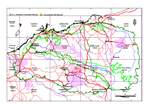Click on images
to enlarge



Photographer: B.R. Maslin

Photographer: B.R. Maslin

Photographer: B.R. Maslin
Botanical name
Acacia ampliceps x bivenosa
Description
Large, bushy, spreading, glabrous shrubs 2-4 (-5) m tall. Bark greenish aging light grey, smooth. Branchlets spreading (not pendulous or sub-pendulous). New shoots light green and shiny, not viscid. Phyllodes narrowly oblong-elliptic to oblanceolate, (5-) 6-12 cm long, 10-25 (-30) mm wide, coriaceous to thinly coriaceous, sometimes very finely wrinkled when dry, mostly ±straight, occasionally shallowly recurved or shallowly incurved, dull green or sub-glaucous, spreading to ±erect, not as severely attacked by leaf-eating insects or pendulous as often occurs is A. ampliceps; with a prominent, yellow midrib and commonly a second, less prominent nerve parallel to it on its on upper side; minor lateral nerves anastomosing; marginal nerve evident and yellowish; the apex obtuse and innocuous. Gland situated on upper margin of phyllode 0-4 mm above the pulvinus, a smaller gland often present at base of the minute apical point. Inflorescences simple and/or racemose, the raceme axes 1.5-4 (-10) cm long and often becoming 'leafy' or growing out at the apex; peduncles (9-) 15-32 mm long; heads globular, 8-15 mm in diameter at anthesis, lemon yellow, 20-35-flowered. Flowers 5-merous; calyx truncate to sinuate-toothed. Pods sub-moniliform, readily breaking into 1-seeded segments at the constrictions between seeds, 4-8 cm long, 5-7 mm wide, woody to coriaceous-crustaceous, yellow-brown. Seeds longitudinal in the pods, obloid, about 5 mm long and 3.5 mm wide, shiny, dark brown; funicle/aril folded beneath the seed, orange-brown and waxy-looking when dry (?red when fresh).
Characteristic features
Large, bushy, spreading, glabrous shrubs. Phyllodes broad and relatively long (mostly 6-12 cm long and 10-25 mm wide), mostly ±straight, green or sub-glaucous, not as severely attacked by leaf-eating insects as is A. ampliceps , midrib prominent and often with a less prominent nerve parallel to it, obtuse. Gland near pulvinus at base of phyllode and often also at base of the minute apical point. Inflorescences simple and/or racemose, raceme axes often 'leafy' or growing out at the apex; heads lemon yellow; peduncles long (mostly 15-32 mm). Pods sub-moniliform, narrow (5-7 mm wide), readily breaking into 1-seeded segments at the constrictions between seeds, woody, yellow-brown.
Distribution and ecology
Scattered in Western Australia from the Pilbara northwards to the Dampier Peninsula (north of Broome) and Fitzroy Crossing in the southern Kimberley region. Of sporadic occurrence in the Pilbara where most collections are from the Dampier - Wickham area; it also occurs southeast to the Hamersley Range and near the Oakover River east of Marble Bar. This hybrid is found (commonly at a low frequency) in populations with the parents, A. ampliceps and A. bivenosa , along drainage lines or diffuse watercourses. Grows in sand or clay soils and appears to tolerate high levels of salinity. This hybrid may be more common than current collections suggest; it can potentially occur wherever its widespread parents come together.
Flowering and fruiting period
Flowers from July to August. Pods with mature seeds have been collected in October and November.
Variation
Because of its hybrid origin there is considerable variation in the shape and size of the phyllodes. Other characters seem less variable.
Affinities
Morphological characters suggest that this entity is a hybrid between A. ampliceps and A. bivenosa; it is often found growing with the two parents. It differs from A. ampliceps in having shorter, straighter, slightly more rigid and often imperfectly 2-nerved phyllodes, lemon-coloured heads, often some inflorescences simple and slightly broader pods. It differs from A. bivenosa in having longer phyllodes and lemon-coloured heads. Acacia ampliceps also hybridizes with A. sclerosperma (see A. ampliceps x sclerosperma subsp. sclerosperma) but these hybrids are less common than A. ampliceps x bivenosa and although they also have lemon yellow flower-heads they are recognized by their narrower, consistently 1-nerved phyllodes and their wider pods.
Notes
Perhaps of some horticultural potential in situation where A. ampliceps is considered appropriate. The hybrid has advantages over A. ampliceps in that it has a more bushy and less straggly growth form, its phyllodes are less prone to attack by insects and its heads are an attractive pale yellow colour (although generally not produced in great profusion).
Conservation status
Not considered rare or endangered.
